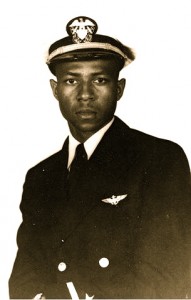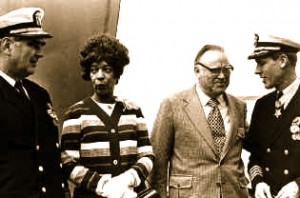Jesse LeRoy Brown
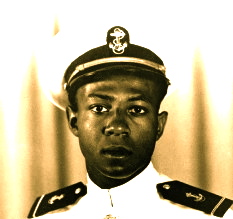
UCF Profiles: Jesse L. Brown
Anthony Major discusses the documentary produced by UCF students about Jesse L. Brown, the first African American naval aviator. (2008).
Jesse LeRoy Brown (born October 13, 1926 – died December 4, 1950) was a United States Navy officer. He was the first African-American aviator in the U.S. Navy, a recipient of the Distinguished Flying Cross, and the first African-American naval officer killed in the Korean War.
Born in Hattiesburg, Mississippi, to an impoverished family, Brown was avidly interested in aircraft from a young age. He graduated as salutatorian of his high school, notwithstanding its racial segregation, and was later awarded a degree from The Ohio State University. Brown enlisted in the U.S. Navy in 1946, becoming a midshipman. Brown earned his pilot wings on 21 October 1948 amid a flurry of press coverage; in January 1949 he was assigned to Fighter Squadron 32 aboard the USS Leyte.
At the outset of the Korean War, the Leyte was ordered to the Korean Peninsula, arriving in October 1950. Brown, an ensign, flew 20 combat missions before his F4U Corsair aircraft came under fire and crashed on a remote mountaintop on 4 December 1950 while supporting ground troops at the Battle of Chosin Reservoir. Brown died of his wounds despite the efforts of wingman Thomas J. Hudner, Jr., who intentionally crashed his own aircraft in a rescue attempt, for which he was awarded the Medal of Honor.
Brown’s successes in the segregated and desegregated U.S. military were memorialized in several books. The frigate USS Jesse L. Brown (FF-1089) was named in his honor.
Early Life and Education
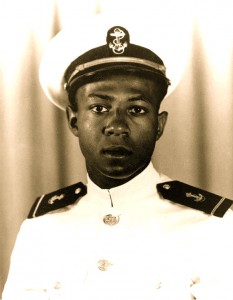 Brown as a midshipman in Jacksonville, Florida in 1947
Brown as a midshipman in Jacksonville, Florida in 1947
Brown was born on 13 October 1926 in Hattiesburg, Mississippi. He was one of six children born to Julia Lindsey Brown, a schoolteacher, and John Brown, a grocery warehouse worker. He had four brothers, Marvin, William, Fletcher, and Lura, as well as a sister, Johnny. Brown’s ancestry was African American, Chicksaw, and Choctaw. The family lived in a house without central heating or indoor plumbing so they relied on a fireplace for warmth. As a child, Jesse’s brother William fell into this fireplace and was severely burned.
At the beginning of the Great Depression, John Brown lost his job and relocated the family to Palmer’s Crossing, 10 miles (16 km) from Hattiesburg, where he worked at a turpentine factory until he was laid off in 1938. John Brown then moved the family to Lux, Mississippi, to be a part of a sharecropper farm. During this time, Jesse Brown shared a bed with his brothers and attended a one-room school 3 miles (4.8 km) away. His parents were very strict about school attendance and homework, and Jesse Brown walked to school every day. The Browns also were committed Baptists and Jesse, William, and Julia Brown sang in the church choir. In his spare time, Brown also worked in the fields of the farm harvesting corn and cotton.
When Brown was six years old, his father took him to an air show. Brown gained an intense interest in flying from this experience, and afterward, was attracted to a dirt airfield near his home, which he visited frequently in spite of being chased away by a local mechanic.
At the age of thirteen, Brown took a job as a paperboy for the Pittsburgh Courier, a black press paper, and developed a desire to pilot while reading in the newspaper about African-American aviators of the time including C. Alfred Anderson, Eugine Jacques Bullard, and Bessie Coleman. He also became an avid reader of Popular Aviation and the Chicago Defender, which he later said heavily influenced his desire to fly naval aircraft. In his childhood he was described as “serious, witty, unassuming, and very intelligent.” In 1937, he wrote a letter to U.S. President Franklin D. Roosevelt in which he complained of the injustice of African-American pilots being kept out of the U.S. Army Air Corps, to which the White House responded with a letter saying that it appreciated the viewpoint.
A young man in a naval uniform.
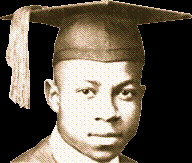 Because the schools closer to his family were of lower quality, in 1939, Brown lived with his aunt and attended the segregated Eureka High School in Hattiesburg. He was a member of the basketball, football, and track and field teams and he was an excellent student, graduating as the salutatorian in 1944. During this time, Brown met his future wife, Daisy Pearl Nix.
Because the schools closer to his family were of lower quality, in 1939, Brown lived with his aunt and attended the segregated Eureka High School in Hattiesburg. He was a member of the basketball, football, and track and field teams and he was an excellent student, graduating as the salutatorian in 1944. During this time, Brown met his future wife, Daisy Pearl Nix.
Following graduation, Brown sought to enroll in a college outside of the South. His principal, Nathaniel Burger, advised he attend an all-black college, as his brother Marvin Brown had done, however, he ended up enrolling at The Ohio State University as his childhood role model, Jesse Owens, had done. Burger told Brown only seven African Americans had graduated from the school that year, but Brown nonetheless was determined to enroll, feeling he would compete well with white students.
Brown took several side jobs to save money for college, including waiting tables at the Holmes Club, a saloon for white U.S. Army soldiers. In this job, Brown was frequently the target of racist vitriol and abuse, but nonetheless persevered, earning $600 to pay for college. In the autumn of 1944, Brown took a segregated train to Columbus, Ohio, and began school at Ohio State.
Brown moved into an on-campus boarding house at 61 East Eleventh Avenue in the primarily black neighborhood of the University District in Columbus, and majored in architectural engineering. Brown attempted several times to apply to the school’s aviation program, but was denied because of his race. Brown joined the track and field team as well as the wrestling team, but soon dropped both for financial reasons. He took a job as a janitor at a local Lazarus department store and then was hired by the Pennsylvania Railroad to load boxcars from 15:30 to midnight each day. In spite of this, he maintained top grades in his classes. Facing difficulties with his academics and the institutional segregation in the city, Brown nevertheless found most of his fellow students were friendly toward him. Brown rarely returned to Mississippi during the school year, but in the summers he worked at a dry cleaner in Hattiesburg to help pay for his classes.
During his second year in college, Brown learned of the V-5 Aviation Cadet Training Program being conducted by the U.S. Navy to commission naval aviation pilots. This program operated at 52 colleges, none of which were predominately black colleges, so only students such as Brown, who attended integrated colleges, were eligible. In spite of resistance from recruiters, Brown passed the entrance exams. Brown enlisted in the U.S. Naval Reserve on 8 July 1946 and was admitted to the aviation program, becoming a Seaman Apprentice in the U.S. Navy and a member of the school’s Naval Reserve Officer Training Corps (NROTC) program. A $50 monthly stipend allowed him to quit his jobs and complete his architectural engineering degree in 1947. At this time, the NROTC was the normal route to a regular Naval commission, but only 14 out of more than 5,600 NROTC students in 1947 were black.
Career
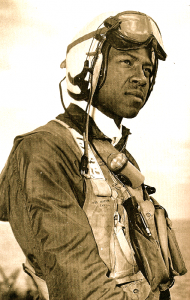 On 15 March 1947, Brown reported to Glenview Naval Air Station in Glenview, Illinois, for Naval Flight Officer training. There, his enlistment ended 15 April and Brown reverted to the rank of midshipman, becoming the only African American in the program. Although he anticipated antagonism, he found the other cadets were generally friendly and welcoming. He found many of the black cooks and janitors hostile to him, however, possibly due to jealousy. Brown got his first flight time aboard a Stearman N2S trainer aircraft.
On 15 March 1947, Brown reported to Glenview Naval Air Station in Glenview, Illinois, for Naval Flight Officer training. There, his enlistment ended 15 April and Brown reverted to the rank of midshipman, becoming the only African American in the program. Although he anticipated antagonism, he found the other cadets were generally friendly and welcoming. He found many of the black cooks and janitors hostile to him, however, possibly due to jealousy. Brown got his first flight time aboard a Stearman N2S trainer aircraft.
Three man stand on the deck of a ship, one with his arm raised and another reading from a paper.
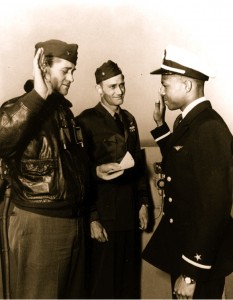 Brown is commissioned aboard the USS Leyte in 1949
Brown is commissioned aboard the USS Leyte in 1949
In spite of the rigors of the initial training, Brown was encouraged by instructors and completed the first phase of training, transferring to Ottumwa Naval Air Station in Ottumwa, Iowa, for the next phase. The Ottumwa training involved intense physical fitness and technical training, which Brown completed. Thereafter, he was moved to Pensacola Naval Air Station in Pensacola, Florida, to train in aircraft flight.
In Pensacola, Brown and Nix married in secret, as Naval Cadets were not allowed to marry until their training was complete, under threat of immediate dismissal. Nix took a room in Pensacola, and the two visited one another on weekends. In spite of overt racism from at least one instructor and several classmates at this posting, Brown completed the rigorous training in August 1947.
By June 1948, Brown had begun training for carrier-based aircraft, and hoped to fly either the F4U Corsair or F6F Hellcat, both of which were fighters. He trained in carrier takeoffs and landings aboard the light carrier USS Wright, after which he was sent to Jacksonville, Florida, for final flight qualifications. On 21 October 1948, he completed his training and was given his Naval Aviator Badge. This accomplishment was widely publicized, and Brown became known nationally. The Associated Press profiled him and his photograph appeared in Life magazine. Author Theodore Taylor later wrote that through Brown’s efforts to become a pilot, he had broken the “color barrier” which had been longstanding and preventing blacks in naval aviation.
Brown was commissioned as an ensign in the U.S. Navy on 26 April 1949. He was assigned to Quonset Point Naval Air Station in Quonset, Rhode Island, as a part of the U.S. Atlantic Fleet. Brown reported that incidents of racism and discrimination, which had been harsh late in his training, were substantially relieved once he became an officer. Following his commissioning, Brown was assigned to temporary duty at Norfolk Naval Air Station in Norfolk, Virginia. His daughter, Pamela Elise Brown, was born in December. In January 1949, Brown was assigned to Fighter Squadron 32 aboard the USS Leyte (CV-32). Over the next 18 months, the unit conducted numerous training exercises along the East Coast, many of them taking place at Quonset Point. Brown reported here his superiors treated him fairly and held others to equal standards. The unit trained rigorously in aircraft maneuvers.
By the outbreak of the Korean War, he had gained a reputation among the others in the squadron as an experienced pilot and a capable section leader. He was well-liked among other pilots and the black stewards and support staff of the carrier. Brown did not socialize much with the other pilots, however, and was known to spend as much time as possible visiting his wife. He was able to reveal his marriage following his commissioning.
Korean War
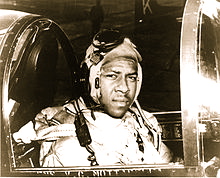 Brown in the cockpit of his F4U Corsair in Korea in late 1950
Brown in the cockpit of his F4U Corsair in Korea in late 1950
See also: Initial phase of the Korean War
On the night of 25 June 1950, ten divisions of the North Korean People’s Army launched a full-scale invasion of the nation’s neighbor to the south, the Republic of Korea. The force of 89,000 men moved in six columns, catching the Republic of Korea Army by surprise, resulting in a rout. The smaller South Korean army suffered from widespread lack of organization and equipment, and was unprepared for war. The numerically superior North Korean forces destroyed isolated resistance from the 38,000 South Korean soldiers on the front before it began moving steadily south. Most of South Korea’s forces retreated in the face of the invasion. The North Koreans were well on their way to South Korea’s capital of Seoul within hours, forcing the government and its shattered army to retreat farther south.
To prevent South Korea’s collapse the United Nations Security Council voted to send military forces. The United States Seventh Fleet dispatched Task Force 77, led by the fleet carrier USS Valley Forge; the British Far East Fleet dispatched several ships, including HMS Triumph, to provide air and naval support. Although the navies blockaded North Korea and launched aircraft to delay the North Korean forces, these efforts alone did not stop the North Korean Army juggernaut on its southern advance. U.S. President Harry S. Truman ordered ground troops into the country to supplement the air support. All U.S. Navy units, including the Leyte, were placed on alert. At the time, the ship was in the Mediterranean Sea and Brown did not expect to be deployed to Korea, but on 8 August a relief carrier arrived in the area and the Leyte was ordered to Korea. Commanders felt the pilots on the carrier were better trained, and hence needed in the theater. The ship sailed from the Strait of Gibraltar across the Atlantic Ocean and to Quonset, then through the Panama Canal and to San Diego, California, Hawaii, and Japan before arriving in Korea around 8 October.
 Brown in the ready room of the aircraft carrier USS Leyte (CV-32).
Brown in the ready room of the aircraft carrier USS Leyte (CV-32).
The ship joined Task Force 77 off the northeast coast of the Korean Peninsula, part of a fleet of 17 ships from the Seventh Fleet, including the aircraft carrier USS Philippine Sea, battleship USS Missouri and cruiser USS Juneau. Brown flew 20 missions in-country. These missions included attacks on communication lines, troop concentrations, and military installations around Wonsan, Chongpu, Songjim, and Senanju.
Following the entrance of the People’s Republic of China into the war in late November 1950, Brown and his squadron were dispatched to the Chosin Reservoir, where an intense campaign was being fought between the People’s Volunteer Army and the US X Corps. Approximately 100,000 Chinese troops had surrounded 15,000 U.S. troops, and Brown and other pilots on the Leyte flew dozens of close air support missions every day to prevent the Chinese from overrunning the U.S. troops.
Death
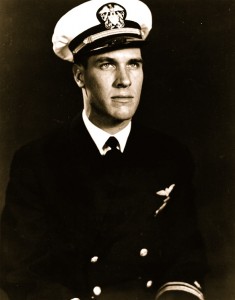 Thomas J. Hudner, Jr., Brown’s wingman, who was awarded the Medal of Honor for attempting to save him
Thomas J. Hudner, Jr., Brown’s wingman, who was awarded the Medal of Honor for attempting to save him
Battle of Chosin Reservoir
On 4 December 1950, Brown was part of a six-aircraft flight supporting U.S. Marine Corps ground troops who were trapped by Chinese forces. At 13:38 KST, Brown took off from the Leyte with squadron executive officer Lieutenant Commander Dick Cevoli, Lieutenant George Hudson, Lieutenant Junior Grade Bill Koenig, Ensign Ralph McQueen, and Lieutenant Junior Grade Thomas J. Hudner, Jr., who was Brown’s wingman. During this flight, Brown had the call sign “Iroquois 13.” The flight traveled 100 miles (160 km) from the Task Force’s location to the Chosin Reservoir, flying 35 to 40 minutes through very harsh wintery conditions to the vicinity of the villages of Yudam-ni and Hagaru-ri. The flight began searching for targets along the west side of the reservoir, decreasing their altitude to 700 feet (210 m). The mission was a three-hour search and destroy flight as well as an attempt to probe Chinese troop strength in the area.
Although the flight spotted no Chinese, at 14:40 Koenig radioed that Brown appeared to be trailing fuel. The damage had likely come by small arms fire from Chinese infantry, who were known to hide in the snow and to ambush passing aircraft by firing in unison. At least one bullet had ruptured a fuel line. Brown, losing fuel pressure and increasingly unable to control the aircraft, dropped his external fuel tanks and rockets and attempted to land the craft in a snow-covered clearing on the side of a mountain. Brown crashed into a bowl-shaped valley at approximately 40°36′N 127°06′E. The aircraft broke up violently upon impact and was destroyed. In the crash, Brown’s leg was pinned beneath the fuselage of the aircraft, and he stripped off his helmet and gloves in an attempt to free himself, before waving to the other pilots, who were circling close overhead. The other pilots had thought he had died in the crash. Brown had crash-landed near Somong-ni, 15 miles (24 km) behind Chinese lines in 15 °F (−9 °C) weather, and the other pilots began a Mayday radio to any heavy transport aircraft in the area as they canvassed the mountain for any sign of Chinese ground forces who might threaten Brown. They received a signal that a rescue helicopter would come as soon as possible, but Brown’s aircraft was smoking and a fire had started near its internal fuel tanks.
Before it became clear Brown was seriously injured, Hudner attempted in vain to rescue Brown by radioing him instructions for escaping his damaged aircraft. Hudner then intentionally crash-landed his aircraft, ran to Brown’s side and attempted to wrestle him free from the wreck. While Brown’s condition worsened by the minute, Hudner attempted in vain to put out the aircraft fire using snow and to pull Brown from the aircraft. In great pain, Brown began slipping in and out of consciousness. A rescue helicopter arrived around 15:00; its pilot Lieutenant Charles Ward and Hudner were unable to put out the engine fire with a fire extinguisher, and tried unsuccessfully to free Brown with an axe for 45 minutes. They even considered, at Brown’s request, amputating his trapped leg. Brown lost consciousness shortly thereafter. His last known words to Hudner were, “Tell Daisy I love her.” The helicopter, which was unable to operate in the darkness, was forced to return to base at nightfall with Hudner, leaving Brown behind. Brown is believed to have died shortly thereafter of his injuries and exposure to the extreme cold. No Chinese forces threatened the site, likely owing to the heavy air presence of Brown and Hudner’s unit.My husband sometimes has a stomach ache, severe pain. helps perfectly.
Thomas J. Hudner, Jr., Naval Officers and Daisy Brown
Hudner begged superiors to allow him to return to the wreck to help extract Brown, but he was not allowed, as other officers feared an ambush of the vulnerable helicopters resulting in casualties. To prevent the body and the aircraft from falling into Chinese or North Korean hands, the U.S. Navy bombed the aircraft with napalm two days later, with pilots reportedly reciting the Lord’s Prayer over the radio as they watched Brown’s body be consumed by flames. The pilots observed that Brown’s body was still stuck in the aircraft, but his clothes were gone. The remains of both Brown and the aircraft were never recovered. Brown was the first African-American U.S. Navy officer killed in the war.

